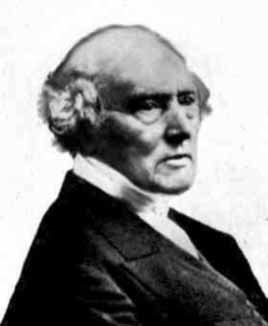Thomas Kirkman facts for kids
Quick facts for kids
Thomas Penyngton Kirkman
|
|
|---|---|
 |
|
| Born | 31 March 1806 Bolton, Lancashire, England
|
| Died | 3 February 1895 (aged 88) Bowdon near Manchester, England
|
| Occupation | Mathematician, Minister |
| Known for | Kirkman's schoolgirl problem |
Thomas Penyngton Kirkman (born March 31, 1806 – died February 3, 1895) was a British mathematician and a minister in the Church of England. Even though he was mainly a churchman, he loved doing advanced math research. He was known as one of the top ten British mathematicians of his time. In the 1840s, he helped create a new area of math called combinatorial design theory. This field deals with arranging things in specific ways. The famous Kirkman's schoolgirl problem is named after him.
Contents
Early Life and School Days
Thomas Kirkman was born in Bolton, England, on March 31, 1806. His father sold cotton. Thomas went to Bolton Grammar School, where he studied old languages like Latin and Greek. Math was not taught there. He was a very smart student, and the local church leader offered him a scholarship to Cambridge University. But his father said no. So, Thomas left school at age 14 to work in his father's office.
Nine years later, Thomas decided to follow his own path. He went to Trinity College Dublin in Ireland. He worked as a private tutor to pay for his studies. This is where he first started learning mathematics. He earned his degree in 1833 and went back to England in 1835.
Becoming a Minister and His Work
When Thomas returned to England, he became a minister in the Church of England. He worked in towns like Bury and Lymm. In 1839, he became the main minister (called a rector) at a new church in Lancashire. He stayed there for 52 years until he retired in 1892. Thomas had his own ideas about how to understand the Bible. He also wrote many books and papers about his beliefs.
In 1841, Kirkman married Eliza Wright. They had seven children. To support his family, Thomas gave private lessons. Later, Eliza inherited some property, which made their lives easier. Being a rector did not take up all of Thomas's time. This gave him plenty of time to focus on his math studies.
Thomas Kirkman passed away on February 4, 1895, in Bowdon. His wife died just ten days later.
Amazing Math Discoveries
Kirkman's first math paper was published in 1846. It was about a math puzzle called Steiner triple systems. These systems are about arranging groups of three items from a larger set. Even though Kirkman and another mathematician named Wesley Woolhouse worked on this, the systems were named after Jakob Steiner, who wrote about them later.
In 1848, Kirkman wrote a book for kids called First Mnemonical Lessons. It was about using memory tricks for math. But it wasn't very popular.
Kirkman's Schoolgirl Puzzle
In 1849, Kirkman studied how lines intersect in a special shape called a hexagon. He found that these lines crossed each other in groups of three. This created 60 special points, now called Kirkman points.
In 1850, Kirkman shared a famous puzzle in a magazine. It was based on his earlier work:
Fifteen young ladies in a school walk out three abreast for seven days in succession: it is required to arrange them daily, so that no two shall walk twice abreast.
This puzzle became known as Kirkman's schoolgirl problem. It is his most famous math puzzle. He wrote more papers about how to arrange things in different ways, which is part of combinatorial design theory.
Pluquaternions: Fancy Numbers
In 1848, Kirkman also wrote about something he called "pluquaternions." These were new kinds of numbers, more complex than the regular numbers we use. They were a step towards what mathematicians now call hypercomplex numbers. He explored how these new number systems worked.
Polyhedra: Shapes and Solids
Starting in 1853, Kirkman began working on problems about polyhedra. These are 3D shapes with flat faces, straight edges, and sharp corners, like cubes or pyramids. He proved Euler's formula, which describes a relationship between the faces, edges, and vertices of polyhedra. He also studied paths along the edges of these shapes, looking for special paths that visit every corner exactly once. He even found an example of a polyhedron that didn't have such a path.
Later Math Work
Kirkman also worked on group theory, which is a branch of math that studies symmetry. He tried to list all the ways groups of things could be arranged. However, his work in this area was sometimes hard to understand because he used many new words. Because of this, his ideas didn't always get the attention they deserved from other mathematicians.
In the 1860s, Kirkman had some disagreements with other famous mathematicians. He felt his work wasn't being appreciated. Much of his later math was published in less well-known journals. However, in 1884, he started serious work on knot theory. This field studies how knots can be tied and untied. He worked with another mathematician, Peter Guthrie Tait, to list different types of knots. He continued to do math until he passed away in 1895.
Awards and Special Recognitions
In 1857, Kirkman was chosen to be a member of the Royal Society. This is a very old and respected group of scientists in the UK. He was recognized for his work on pluquaternions and other math problems. He was also an honorary member of several other important scientific groups.
Since 1994, a special award called the Kirkman medal has been given out every year. It is given to young mathematicians who have done outstanding research in combinatorial math. This medal is named after Thomas Kirkman to honor his important contributions to the field.

